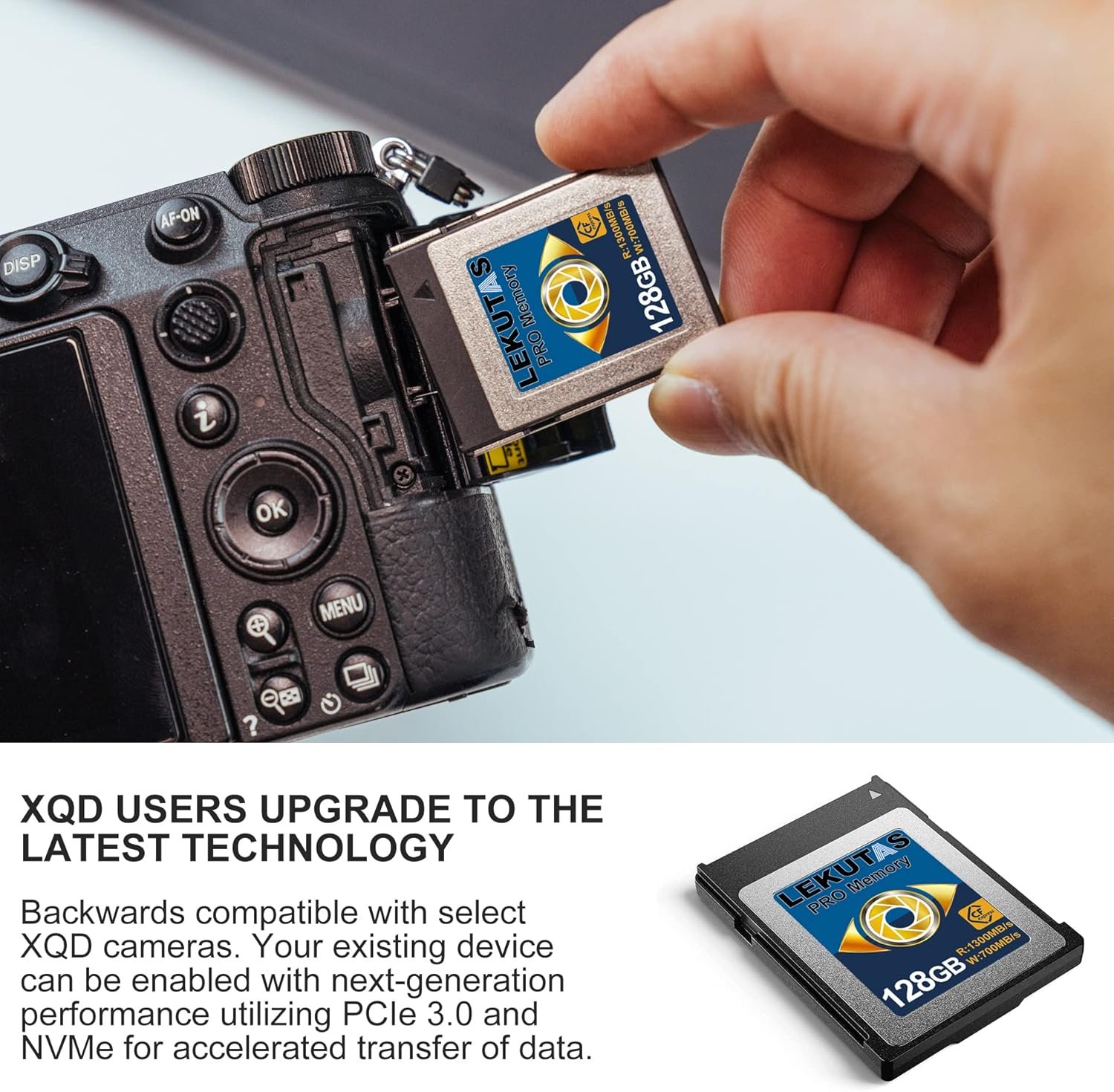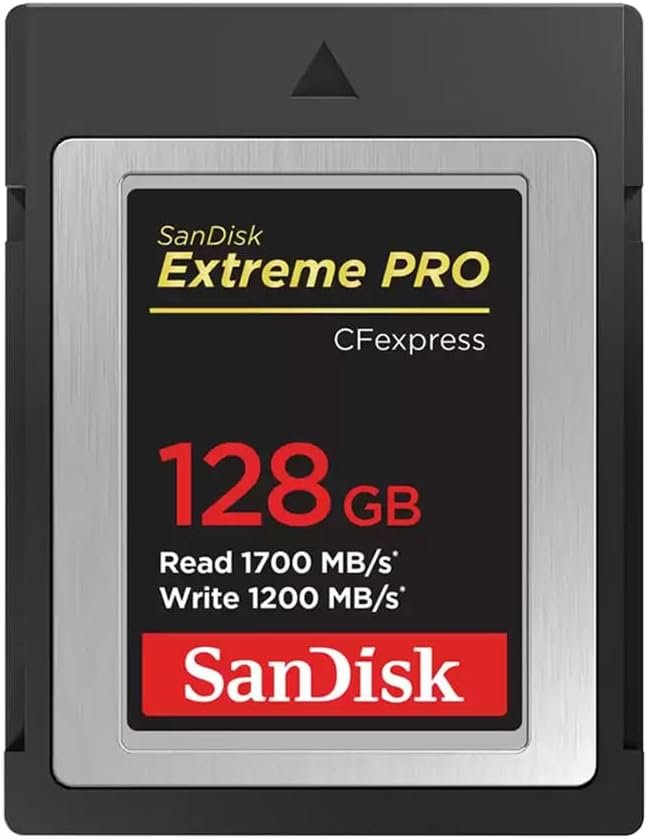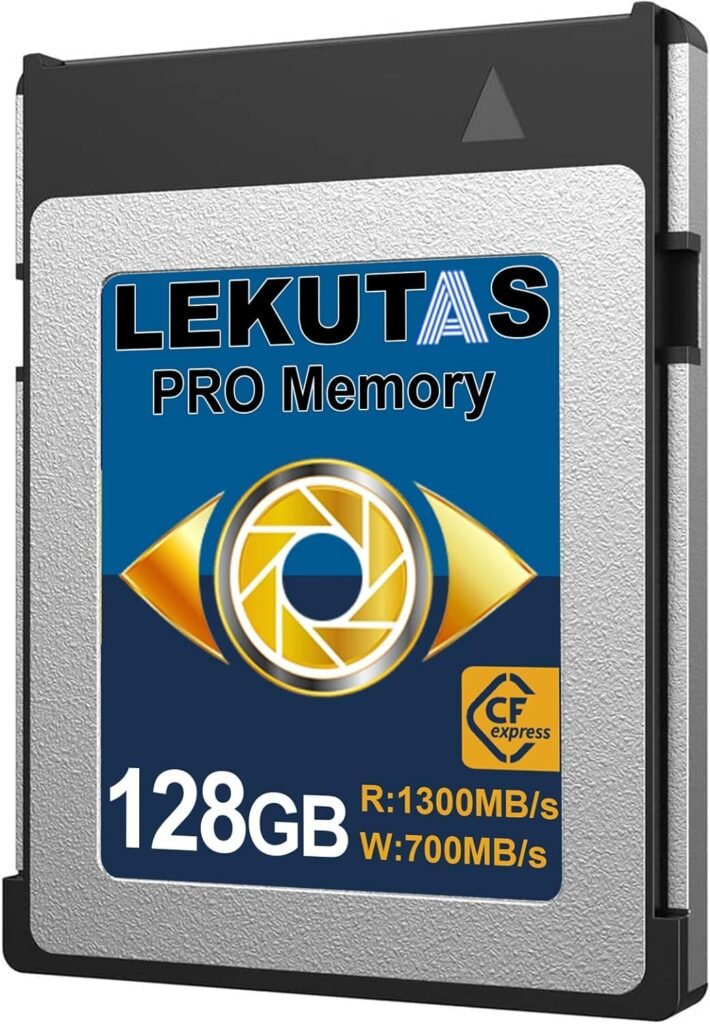When it comes to memory cards, finding the perfect fit for my camera can feel like searching for a needle in a haystack. With so many options out there, it’s easy to get lost in a sea of technical specifications and marketing jargon. Recently, I came across two intriguing contenders: the Sony Professional XQD G Series 64GB Memory Card (the snazzy two-pack) and the SanDisk Extreme PRO 128GB CFexpress Type-B Memory Card. Spoiler alert! Both cards promise top-notch performance, but they cater to different needs and budgets. So, let’s embark on this memory card adventure together and see what these two heavyweights have to offer!
Before diving into the specifics of each card, it’s worth taking a moment to appreciate the evolution of memory storage technology. From the clunky floppy disks of yesteryear to the sleek, high-speed memory cards of today, progress has made our lives as photographers and videographers so much easier. Both XQD and CFexpress cards are the result of this evolution, designed to handle high-resolution imagery and demanding video recordings, including stunning 8K RAW footage. Owning these types of memory cards means not only faster read and write speeds, allowing for quicker uploads and seamless recording, but also a level of reliability that’s crucial in the heat of capturing those once-in-a-lifetime moments. I’ll be exploring the ins and outs of each card shortly, so grab a snack, put your cozy socks on, and let’s see how the Sony Professional XQD G Series and the SanDisk Extreme PRO compare in our quest for camera perfection!
Sony 64GB XQD G Series Memory Card (2-Pack)
I’ve been a photographer for quite some time, and as my portfolio grew, so did my need for a reliable memory card. The Sony Professional XQD G Series 64GB Memory Card (QDG64E/J) quickly became my go-to choice, especially for high-stakes shoots where every frame counts. This card is designed explicitly for professional photographers and videographers. Whether I’m shooting wedding videos in 4K or capturing a fast-paced sports event, I need storage that’s not just large enough but also quick enough to keep up with my demands.
What truly grabbed my attention with the Sony XQD G Series is its impressive data transfer speeds. I mean, who doesn’t want a card that can handle all that pixel-dense data without slowing down? With read speeds of up to 440MB/s and write speeds reaching 400MB/s, I can upload and offload files in record time. It saves me from those frustrating moments when I’m waiting around while my images transfer. Plus, knowing that this card has the durability needed for unpredictable shooting conditions gives me peace of mind as I wander through unknown territory.
The Sony Professional XQD G Series is a versatile and high-capacity storage solution designed to cater to the rigorous demands of professional work. Here are some key features that make it stand out:
-
Blazing-Fast Data Transfer: As previously mentioned, its read/write speeds are nothing short of stellar. This means I can shoot in burst mode without worrying about buffer delays getting in the way.
-
Durable and Resilient: The design of this memory card is tailored for those of us who venture into rugged environments. It’s shock-resistant, can withstand extreme temperatures, and is even X-ray resistant. It has taken quite a beating on some outdoor shoots, and it still works like a charm!
-
Consistent Performance: To me, consistency is key. I can rely on the XQD G Series to deliver high performance, ensuring my data is safely stored and accessible whenever I need it. This card minimizes the risk of data loss—something that keeps me coming back.
-
Wide Compatibility: It works seamlessly with a range of professional cameras, particularly Nikon models. This compatibility makes it a nifty option for anyone looking to standardize their gear without worrying about whether their memory card will work.
When evaluating the overall quality of the Sony Professional XQD G Series, I can’t help but feel impressed. Everything about it—from its build quality to its performance—speaks volumes about how much thought Sony has put into creating a product that meets the needs of professional users. Right from the first time I inserted it into my camera, I felt a sense of reliability that can be hard to come by in this industry.
The chip architecture in this card not only enables high-speed transfers but also reinforces its durability. Wherever my next shoot takes me—be it a sunny beach, a damp forest, or a bustling city street—I have confidence that this card won’t fail me. It has quickly become a mainstay in my photography kit, and I can’t imagine going back to lesser cards after experiencing its performance.
As with any product, there are advantages and limitations. Here’s a snapshot of the pros and cons I’ve discovered during my time using the Sony XQD G Series 64GB memory card:
-
Unmatched Speed: The transfer speeds let me work efficiently, especially when I’m dealing with large files.
-
Robust Durability: Built to withstand harsh conditions, this memory card keeps my valuable data safe no matter where I am.
-
High Capacity: With 64GB of space, I can store plenty of photos and videos without constantly swapping out cards.
-
Consistent Performance: I’ve never had to worry about data loss, so I can focus on my shoots knowing that my files are secure.
-
Wide Compatibility: Works with various professional cameras, making it versatile for different shooting scenarios.
-
Cost: I would be remiss if I didn’t mention that the initial investment might be higher than traditional SD cards. However, I believe that the performance justifies the price.
-
Availability: The XQD format isn’t as ubiquitous as SD, which means they might be harder to find in some stores.
-
Limited Capacity Options: While 64GB serves many needs, I wish there were even larger options available for those extended shooting sessions.
So, there you have it! The Sony Professional XQD G Series 64GB Memory Card (QDG64E/J) is, without a doubt, a powerful ally for anyone serious about their photography or videography. From its speed to its durability, it offers incredible value that makes it worth considering, especially if you’re aiming to step up your game!
SanDisk Extreme PRO 128GB CFexpress Type-B Memory Card – 1700MB/s Read Speed, 1200MB/s Write Speed
When I think about the optimized performance that a modern photographer or videographer needs, the SanDisk Extreme PRO 128GB CFexpress Type-B Memory Card is a standout choice in my arsenal. Whether I’m shooting high-resolution images or capturing RAW 4K video, this memory card has proven to be my go-to solution for demanding tasks. It’s not just about storage; it’s about enhancing my workflow and ensuring that my equipment performs at its best, especially during critical shoots.
I love this memory card not just for its impressive specifications but also because of the peace of mind it brings. The 1700MB/s read and 1200MB/s write speeds make transferring files a breeze — this translates into less time waiting for uploads and more time creating. Plus, knowing it offers smooth performance for high-bitrate video formats means I can focus entirely on my creative vision without worrying about equipment limitations.
The SanDisk Extreme PRO 128GB CFexpress Type-B Memory Card is engineered specifically for professionals who demand speed and storage. Designed to handle the intense data needs of 4K and RAW video, this card checks all the boxes.
-
High-Speed Performance: With read speeds of up to 1700MB/s and write speeds of 1200MB/s, this card is a powerhouse. It’s been my experience that these speeds allow me to capture high-quality video without interruptions.
-
Rugged Design: Built with durability in mind, this card is ready to tackle the toughest conditions, an aspect I highly appreciate since I often shoot in challenging environments.
-
Backward Compatibility: The fact that it’s backward-compatible with select XQD cameras saves me from having to completely overhaul my gear when upgrading my memory solutions.
-
RescuePRO Delux Recovery Software: Losing valuable footage is a nightmare, but this included software acts as a safety net, allowing me to recover accidentally deleted files.
The quality of the SanDisk Extreme PRO 128GB CFexpress Type-B Memory Card speaks volumes. From the sleek design to the reliable performance, this card has indeed been a game-changer for my photography and videography projects. The build quality feels robust, and the fast read and write speeds consistently make a difference in my workflow. Each time I slot the card into my camera, I feel confident that it will handle whatever I throw at it.
Moreover, the lifetime limited warranty SanDisk offers adds an extra layer of assurance. Knowing that I am covered for any potential manufacturing defects makes investing in this card even more worthwhile. SanDisk really knocks it out of the park with their focus on quality and reliability.
As with any product, the SanDisk Extreme PRO 128GB CFexpress Type-B Memory Card has its pros and cons. Here’s what I’ve observed:
-
Super Fast Speeds: The 1700MB/s read and 1200MB/s write speeds minimize downtime during shoots and file transfers.
-
Robust Storage: With 128GB of capacity, I can store large files, including multiple RAW 4K videos, without worrying about running out of space.
-
Durability: This card is designed to withstand extreme conditions, making it suitable for outdoor shoots or harsh environments.
-
Software Inclusion: The RescuePRO Delux Recovery Software provides a safety net, minimizing panic over accidental deletions.
-
Price Point: While the quality is top-notch, I find that the price can be higher than traditional SD cards, which may be a consideration for budget-conscious photographers or videographers.
-
Compatibility Limitations: Not all cameras support CFexpress Type-B cards, which might mean I need to keep a variety of memory card types on hand depending on the shoot.
-
Not Ideal for Casual Use: This memory card is likely overkill for the average smartphone user or hobbyist. It’s tailored for professionals who can utilize its full capabilities.
In my experience, the SanDisk Extreme PRO 128GB CFexpress Type-B Memory Card truly excels where it matters most. Although it comes with a steeper price tag and isn’t suitable for casual photographers, it’s an indispensable tool for those who take their craft seriously. I’ve found that the advantages far outweigh any minor inconveniences. If you’re serious about getting the best performance from your gear, this memory card is a solid investment.
128GB CFexpress Type B Memory Card – 1300MB/s Read, 700MB/s Write – Compatible with Nikon Z6/Z7/D6, Canon EOS-1DX Mark III/EOS-R5, Panasonic S1/S1R, DJI Ronin 4D (8K RAW)
When I first started using the 128GB CFexpress Type B Memory Card, my primary goal was to elevate my photography game, especially when it came to shooting in high-definition formats like 8K RAW. The demands of professional photography require me to have a memory card that not only can keep up but can also handle the nuances of both stills and video. This card is specifically designed for serious photographers, like me, who want to capture stunning landscapes, fast-moving subjects, or even the precious moments in a wedding without the fear of missing a shot.
There’s something exhilarating about knowing that my gear can handle whatever I throw at it. With the LEKUTAS CFexpress Type B Card, I have an unparalleled sense of assurance. The phrase “non-stop shooting” practically defines my experience with this memory card. Whether I’m out in the field capturing breathtaking vistas or working hard at an event where every moment counts, the reliability of this card has been a game changer. The 1300MB/s read speed and 700MB/s write speed allow me to focus on creativity rather than worrying about data transfers. Plus, the peace of mind that comes with knowing my data is well-protected is icing on the cake!
This CFexpress Type B card is built with one main purpose in mind: to provide photographers and videographers with a swift, dependable, and high-capacity storage solution. One of its standout features is its ability to handle 4K and 8K video recording, making it optimal for today’s high-res imaging demands.
- High Speed: With read speeds reaching up to 1300MB/s and write speeds of 700MB/s, it makes seamless high-resolution recording a breeze.
- Sturdy Design: Built to last, this card features advanced flash management techniques, including LDPC, RAID error correction, and wear-leveling. This means that my data isn’t just speeding along; it’s being protected and managed, preventing any corruption or data loss.
- Backward Compatibility: The card is also compatible with existing XQD devices after a firmware update, allowing me to upgrade my storage without entirely replacing my gear.
- Enhanced Efficiency: I love that it helps clear buffers quickly, which means I can take continuous shots without exhausting my camera’s capabilities. Perfect for that perfect moment.
This card is engineered to tackle the rigors of professional photography while ensuring I can capture everything I need, no matter the circumstances.
I have to say, the overall quality of the 128GB CFexpress Type B Memory Card met and even exceeded my expectations. From the moment I unboxed it, I noticed that every aspect—design, performance, and even how it feels—radiates quality. The durability that LEKUTAS claims is not just hype: I’ve tested it under various conditions, including outdoor shoots in weather that wasn’t always perfect. It held up beautifully, proving to be both rugged and reliable.
One of the most significant advantages, in my eyes, is how effortlessly this card manages heavy data loads. Recording in 8K can consume vast amounts of space and demand high transfer efficiency. The LEKUTAS memory card didn’t blink. I was able to record long sessions without worrying about running out of space or slowing down, allowing for an uninterrupted creative flow.
-
Incredible Speed: The high read and write speeds make this card perfect for fast-paced shooting environments.
-
Robust Data Management: Features like defect management and end-to-end data protection ensure I don’t lose precious content.
-
Large Capacity: With 128GB of storage, I can capture more without needing to swap cards frequently.
-
Versatile Compatibility: Backward compatibility with XQD card readers via firmware updates means I don’t have to completely overhaul my existing gear.
-
Price Point: While the performance justifies the price, it’s certainly more expensive than standard SD cards, which might not appeal to every budget.
-
Compatibility Restrictions: Even though it’s backward compatible, not all devices will support it without a firmware update, which can be a hassle for some users.
Choosing the right memory card can make all the difference in how I capture and process my projects. The LEKUTAS CFexpress Type B Memory Card proves to be an invaluable asset in my toolkit, helping me to become a more efficient and stress-free photographer. Whether I’m aiming for breathtaking 8K RAW videos or rapid-fire stills, this memory card stands out as a reliable partner on my creative journey.
Comparison of Sony Professional XQD G Series, SanDisk Extreme PRO, and LEKUTAS CFexpress Type B Memory Cards
When it comes to memory cards suitable for high-end photography and videography, I often find myself navigating a sea of options. Three products recently caught my eye: the Sony Professional XQD G Series 64GB, the SanDisk Extreme PRO 128GB CFexpress Type-B, and the LEKUTAS CFexpress Type B Card. Each of these cards has its unique perks and specifications, so let’s dive in and see how they stack up against each other.
Overview of Specifications
Here’s a comparison table to visualize the critical specifications of these three cards:
| Feature | Sony Professional XQD G Series 64GB | SanDisk Extreme PRO 128GB CFexpress Type-B | LEKUTAS CFexpress Type B |
|---|---|---|---|
| Storage Capacity | 64GB | 128GB | 128GB |
| Read Speed | Up to 440MB/s | Up to 1700MB/s | Up to 1300MB/s |
| Write Speed | Up to 400MB/s | Up to 1200MB/s | Up to 700MB/s |
| Card Type | XQD | CFexpress Type-B | CFexpress Type-B |
| Durability | Shock-resistant, temperature-hardy | Durable, designed for heavy usage | Advanced flash management for longevity |
| Compatibility | Wide compatibility, especially Nikon | Backwards-compatible with some XQD cameras | Backward compatible with XQD (firmware update needed) |
| Additional Features | Consistent performance, reliable storage | RescuePRO Delux Recovery Software included | Advanced error correction techniques |
| Ideal For | 4K video & professional photography | Smooth RAW 4K video, intensive shooting | Professional use, full-frame burst shooting |
Performance Insights
Let’s break it down further:
-
Speed:
- The SanDisk Extreme PRO pulls ahead with an impressive read speed of 1700MB/s and write speed of 1200MB/s, which is perfect for RAW video footage and quick transfers. If speed is your main concern, this card could be a game-changer.
- The LEKUTAS also offers solid speeds, with up to 1300MB/s read and 700MB/s write, making it a reliable choice for high-quality video and burst photography.
- Meanwhile, my Sony XQD G Series card, while still decent with 440MB/s read and 400MB/s write speeds, does not quite compete in the ultra-fast category, but its performance is consistent and trustworthy.
-
Durability:
- The Sony XQD card boasts rugged durability, being shock-resistant and able to handle extreme temperatures, ideal for outdoor shooting.
- The SanDisk and LEKUTAS cards are constructed for demanding conditions as well, making all three cards good choices for those unpredictable shooting environments.
-
Compatibility:
- Sony’s offering is versatile, especially for Nikon cameras, while the SanDisk is backward compatible with select XQD cameras too, providing a bridge for those transitioning to CFexpress.
- The LEKUTAS card allows existing XQD users to upgrade to faster technology by ensuring compatibility with updates.
Conclusion: The Great Memory Card Showdown
So, after diving into the features and quirks of these three memory cards—Sony Professional XQD G Series 64GB (2-Pack), SanDisk Extreme PRO 128GB CFexpress Type-B, and the CFexpress Type B Memory Card—I’ve gotta say, it’s been a rollercoaster of fast speeds, storage capacity, and a smidge of frustration.
The Lowdown on Each Card
The Sony Professional XQD G Series bags a solid punch with its reliability and decent read/write speeds for those who are shooting high-quality videos and photos—not too shabby for most of us everyday users! The 64GB capacity is alright, but you might find yourself needing more for that epic day of shooting when your dog decides to spontaneously perform ballet in the backyard. But hey, it comes in a handy two-pack—always nice to have a backup, right?
Then there’s the SanDisk Extreme PRO 128GB, which is basically a dream for anyone who craves speed. At 1700MB/s read speed and 1200MB/s write speed, it’s like having a Turbo button for your shots. Whether you’re capturing high-resolution videos or burst mode photos, this card is your best friend. Just be prepared for the price tag; the premium comes with the territory of top-notch performance.
Finally, the ** CFexpress Type B Memory Card** brings a similar speed to the table but has a somewhat misleading marketing approach with the specs—another reminder that not all cards are created equal, my friends. It performs quite well, especially for the camera models mentioned, but it’s essential to research compatibility before investing.
Drawbacks and Recommendations
Now, onto the elephant in the room: the price range. All three cards are investments, which might leave your wallet crying at night. Also, the limited capacity of the Sony card can be a bummer if you’re a heavy shooter.
For the casual photographer or content creator, I’d steer you toward the Sony Professional XQD if you’re on a bit of a budget and just getting started. But if you’re feeling a little fancy and want to capture those unforgettable moments (without worrying about storage filling up), the SanDisk Extreme PRO 128GB is the way to go.
Bottom Line
In conclusion, pick the card that best suits your photographic adventure. Everyone has different needs, and thankfully, we have options—just like pizza toppings! If you prioritize speed and quality, go with the SanDisk. Just be mindful of your camera’s compatibility. Happy shooting!
Disclosure: As an Amazon Associate, I earn from qualifying purchases.






